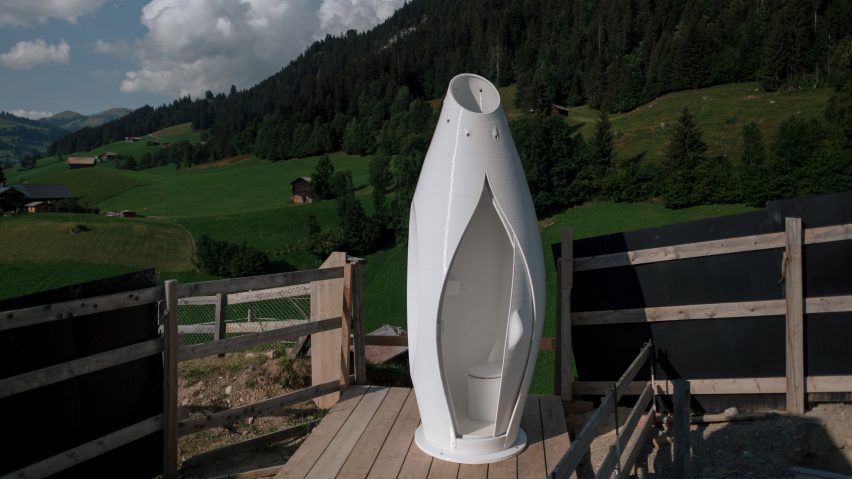Discarded plastic medical equipment from hospitals across Europe was melted into a filament and 3D-printed to create the mobile toilet cubicle The Throne, designed by Spanish studio Nagami for the To.org foundation.
The portable toilet was produced over the course of three days and comprises three parts – a teardrop-shaped body, a dramatic, double-curved sliding door and a collection bucket for solid waste.
These are combined with an off-the-shelf separation toilet seat, which diverts the urine while the solids are composted so they can be put to use locally as a fertiliser.
The first prototype, which is currently being trialled on a building site in the Swiss Alps, was produced by an advanced seven-axis robotic printer in Nagami's studio in Avila.
But the hope is that ultimately, this process for 3D-printing complex structures with recycled plastic could be adopted using more readily available, local technology.
As 91 per cent of all plastic waste produced to date is still waiting to be recycled, To.org founder Nachson Mimran said this abundant material could help to create accessible and affordable sanitation and shelter where they are needed most.
"Plastic waste is a very low cost, inexhaustible resource," Mimran told Dezeen.
"The Throne is a proof of concept for it can be used to create large structures that are both aesthetically pleasing and immensely useful," he added.
"But the cost of production needs to drop before this can be a viable solution for building structures in places like refugee settlements and urban slums."
The Throne project is an evolution of the Bottle Brick Toilets that To.org set up in the slums of Kampala, Uganda, in 2018, which used bricks made from plastic bottles as their structure to simultaneously tackle the lack of management systems for both human and plastic waste.
Nagami, which specialises in 3D-printed furniture, decided to build on this idea for The Throne by sourcing a filament made from recycled plastic medical trays by Dutch company ReFlow.
This is combined with a number of mechanical elements such as metal rails, which are inserted into the frame as it is being printed to accommodate the sliding door.
To prevent the accumulation of dirt and bacteria, Nagami had to avoid the use of 3D printing for the actual toilet seat, as the process creates distinctive grooves rather than a smooth, hygienic finish.
So the team decided to incorporate an off-the-shelf compost toilet instead.
"We wanted to demonstrate that large-scale 3D printing can offer much more than ornamental pieces and single material elements," said Nagami CEO Manuel Jiménez García.
"Indeed, it allows for the integration of other pieces, materials and textures, opening the door for the creation of objects, which combine different features that are commonly hard to achieve through 3D printing."
To.org, which was founded by brother Nachson and Arieh Mimran in 2013, is a hybrid between a charitable foundation and a venture capital fund that invests in ethical businesses and funds philanthropic projects.
Although additive manufacturing is increasingly being used to create homes and entire neighbourhoods, similar large-scale work using recycled plastic filaments is still in its infancy.
Elsewhere, designers are already using the material to 3D-print chairs, electric tricycles and even podiums for the 2020 Tokyo Olympics.
The photography is by Dmitry Kostyukov.

